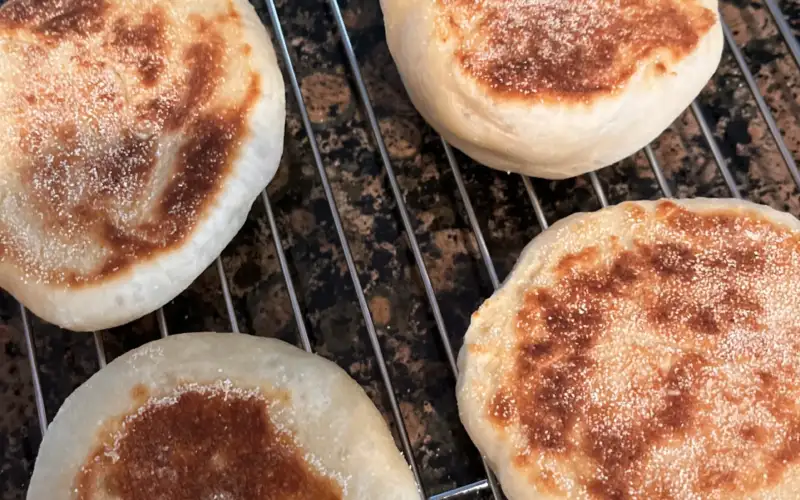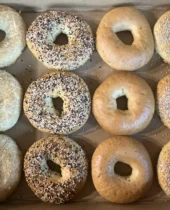Easy English Muffins
Light, fluffy and full of nooks and crannies

Soft, fluffy, skillet-cooked muffins with golden crusts and perfect nooks for butter.
English muffins might seem like a bakery-only item, but they actually date back to 19th-century England as a stovetop griddle bread. Unlike sweet muffins, these are yeast-leavened and cooked instead of baked—making them a totally different category of bread that’s ideal for everyday toasting, slathering with butter, or turning into the world’s best breakfast sandwich.
Once you make them from scratch, the difference is undeniable: crisp golden outsides, soft insides, and those signature air pockets that soak up butter like nothing else.
“Once I made these from scratch, I never bought another store-bought muffin again!”
Why You’ll Love These
Skip the store-bought muffins—this easy recipe delivers that café-style English muffin texture at home. No oven, no fuss, and definitely no complicated techniques. Just a few everyday ingredients, a bit of rise time, and a quick cook in your skillet. The result? Fluffy centers, crispy edges, and all the nooks and crannies your toaster dreams about.
Ingredients & Substitutions
Here’s what you’ll need—and how to customize it if needed:
| Ingredient | Why It Matters | Substitutions / Notes |
|---|---|---|
| All-Purpose Flour | Soft but structured texture | Bread flour for a chewier bite |
| Instant Yeast | Quick rise, no proofing needed | Active dry yeast (bloom in warm water first) |
| Whole Milk | Adds richness and softness | Any milk, dairy or non-dairy |
| Granulated Sugar | Feeds yeast and helps browning | Honey or maple syrup (adjust for sweetness) |
| Large Egg | Adds moisture and structure | Flax egg for a vegan version |
| Unsalted Butter | Enriches the dough | Vegan butter or margarine |
| Salt | Balances flavor | Optional for low-sodium diets |
| Cornmeal | Adds texture and prevents sticking | Semolina flour or all-purpose flour |
Serving Ideas
These muffins are super versatile and go far beyond just “toast and butter.” Some ideas:
- Breakfast Classic: Toasted with salted butter and jam
- Savory Sandwich: Fill with eggs, bacon, and cheese for a homemade Egg McMuffin
- Avocado Toast Upgrade: Toasted, smashed avocado, and a sprinkle of red pepper flakes
- Mini Pizza Bases: Toast, spread marinara, top with cheese and broil
- Sweet Treat: Toasted with Nutella and sliced bananas
Make-Ahead Tips
Want to prep these in advance? Here are your options:
- Overnight Rise: After kneading, cover and refrigerate the dough overnight. Let come to room temp before shaping and rising.
- Freeze for Later: Cook, cool completely, then store in an airtight bag. Freeze up to 3 months. Toast directly from frozen—no thawing needed.
- Fridge Proofing: You can also refrigerate the shaped muffins on a tray overnight, covered well. Let sit at room temp 30 minutes before cooking.
Frequently Asked Questions
Can I use whole wheat flour?
Yes! Replace up to 50% of the all-purpose flour with whole wheat for a heartier muffin. Add 1–2 extra tablespoons of warm water if needed.
Can I skip the egg?
You can use a flax egg (1 tbsp ground flax + 2.5 tbsp water) for a vegan version, though the texture will be slightly less rich.
Why do I need cornmeal?
It keeps the dough from sticking while resting and cooking, and adds that signature texture on the bottom. You can swap with semolina or just use flour in a pinch.
Can I bake these instead of skillet-cooking?
Traditional English muffins are cooked on the stovetop, but you can bake them at 375°F (190°C) for 10–12 minutes. However, you’ll miss the crisp skillet finish!
Why fork-split instead of cutting with a knife?
Fork-splitting helps preserve the signature “nooks and crannies” that define English muffins. A knife flattens them out and ruins that fluffy texture.
Easy English Muffins
Prep Time: 1 hour 20 minutes
Cook Time: 10 minutes
Total Time: 1 hour 30 minutes
Servings: 12 Muffins
Equipment
Hand or Stand Mixer
Parchment Paper
Silicone Mat (optional)
Bench Scraper or Sharp Knife
Spatula
Bowl Scraper (optional)
Large Skillet or Electric Griddle
Ingredients
3 cups (350g) All-Purpose Flour
2 1/4 teaspoons (7g) Yeast, Instant or Fast Acting
1 teaspoon (6g) Salt
2 tablespoons (24g) White Sugar
3/4 cup (165 mL) Whole Milk
1/2 cup (110mL) Warm Water
3 tablespoons (36g) Butter, melted
1 Large Egg, Room Temperature
Cornmeal, as needed to prevent sticking
Directions
Instructions
Step 1: Mix the Dough
- – In the bowl of a stand mixer or a large mixing bowl, combine the all-purpose flour, yeast, salt, and sugar.
- – In a separate bowl, or large measuring cup, warm the milk and water together until lukewarm (about 100°F or 38°C).
- – Add the warm milk-water mixture to the dry ingredients along with the melted butter and beaten egg.
- – Using the paddle attachment (or spatula if mixing by hand), mix the ingredients until a sticky dough forms.
- – Knead the dough for about 5-7 minutes (if using a stand mixer) or about 10 minutes by hand, until smooth and elastic.
Warning: The dough will be slightly wet and sticky!
Step 2: First Rise
- – Lightly oil a bowl and place the dough inside. Cover the bowl with a damp cloth or plastic wrap.
- – Allow the dough to rise in a warm, draft-free area for about 1 hour, or until doubled in size.
Step 3: Shape the Muffins
- – Once the dough has risen, punch it down gently to remove the air.
- – Transfer the dough to a lightly floured surface.
- – Roll out the dough to about ½ inch thickness.
- – Using a round cutter (about 3 inches in diameter), cut out 12 muffin rounds. If you don’t have a cutter, you can use a sharp knife or bench scraper to cut the dough into squares.
Step 4: Prepare for Cooking
- – Line a baking sheet with parchment paper or a silicone mat and sprinkle with cornmeal.
- – Arrange the cut dough rounds on the prepared baking sheet, spacing them 1/2 an inch apart.
- – Cover the dough rounds with a cloth or loosely with plastic wrap and let them rest for about 30 minutes to allow a slight second rise.
Step 5: Cook the Muffins
- – Preheat a large cast-iron skillet or electric griddle over medium-low heat.
- – Sprinkle a small amount of cornmeal and carefully transfer the dough rounds to the hot skillet, being careful not to overcrowd them.
- – Cook for about 4-5 minutes on each side, or until golden brown and cooked through. Use a spatula to flip them gently.
- – You may need to adjust the heat to prevent them from burning before fully cooking through.
Cook in batches to ensure there is no crowding and muffins cook evenly
Step 6: Cool and Serve
- – Slice them open with a fork (to get the signature nooks and crannies), toast, and enjoy with your favorite butter, jam, or toppings.
Baker’s Tips
- Don’t over-flour – A slightly sticky dough makes for the best texture.
- Chill overnight – For even more flavor, let the dough rise in the fridge overnight.
- Fork-split only – Preserve those crannies by pulling the muffins apart with a fork, not slicing.
- Gentle on the flip – Don’t press down while cooking; you’ll lose those fluffy air pockets.
Final Thoughts from My Kitchen to Yours 💛
Once you try these homemade English muffins, it’s hard to go back to store-bought. There’s something deeply satisfying about transforming simple ingredients into golden, fluffy rounds full of character and comfort. Whether you’re making a cozy weekend breakfast or meal-prepping for the week ahead, these muffins bring that little extra joy to the table—no oven, no fuss, just honest homemade goodness.
Happy baking—and don’t forget the fork-split!
